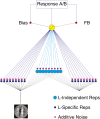An integrated reweighting theory of perceptual learning
- PMID: 23898204
- PMCID: PMC3746919
- DOI: 10.1073/pnas.1312552110
An integrated reweighting theory of perceptual learning
Abstract
Improvements in performance on visual tasks due to practice are often specific to a retinal position or stimulus feature. Many researchers suggest that specific perceptual learning alters selective retinotopic representations in early visual analysis. However, transfer is almost always practically advantageous, and it does occur. If perceptual learning alters location-specific representations, how does it transfer to new locations? An integrated reweighting theory explains transfer over retinal locations by incorporating higher level location-independent representations into a multilevel learning system. Location transfer is mediated through location-independent representations, whereas stimulus feature transfer is determined by stimulus similarity at both location-specific and location-independent levels. Transfer to new locations/positions differs fundamentally from transfer to new stimuli. After substantial initial training on an orientation discrimination task, switches to a new location or position are compared with switches to new orientations in the same position, or switches of both. Position switches led to the highest degree of transfer, whereas orientation switches led to the highest levels of specificity. A computational model of integrated reweighting is developed and tested that incorporates the details of the stimuli and the experiment. Transfer to an identical orientation task in a new position is mediated via more broadly tuned location-invariant representations, whereas changing orientation in the same position invokes interference or independent learning of the new orientations at both levels, reflecting stimulus dissimilarity. Consistent with single-cell recording studies, perceptual learning alters the weighting of both early and midlevel representations of the visual system.
Keywords: Hebbian models; reweighting models.
Conflict of interest statement
The authors declare no conflict of interest.
Figures



References
-
- Ball K, Sekuler R. Direction-specific improvement in motion discrimination. Vision Res. 1987;27(6):953–965. - PubMed
-
- Fahle M, Morgan M. No transfer of perceptual learning between similar stimuli in the same retinal position. Curr Biol. 1996;6(3):292–297. - PubMed
-
- Fiorentini A, Berardi N. Perceptual learning specific for orientation and spatial frequency. Nature. 1980;287(5777):43–44. - PubMed
-
- Ramachandran V, Braddick O. Orientation-specific learning in steropsis. Perceptn. 1973;2(3):371–376. - PubMed
-
- Ahissar M, Hochstein S. Task difficulty and the specificity of perceptual learning. Nature. 1997;387(6631):401–406. - PubMed
Publication types
MeSH terms
Grants and funding
LinkOut - more resources
Full Text Sources
Other Literature Sources

